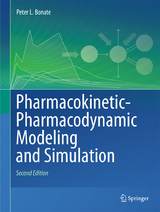
Pharmacokinetic-Pharmacodynamic Modeling and Simulation
Seiten
2005
Springer-Verlag New York Inc.
978-0-387-27197-2 (ISBN)
Springer-Verlag New York Inc.
978-0-387-27197-2 (ISBN)
- Titel erscheint in neuer Auflage
- Artikel merken
Zu diesem Artikel existiert eine Nachauflage
Aims to present through theory and example how to develop pharmacokinetic models, both at an individual and population level. In order to do so, one must first understand linear models and then build to nonlinear models followed by linear mixed effects models and then ultimately nonlinear mixed effects models. This book develops in that manner.
A natural hierarchy exists in pharmacokinetic-pharmacodynamic modeling culminating in population pharmacokinetic models, which are a specific type of nonlinear mixed effects model. The purpose of this book is to present through theory and example how to develop pharmacokinetic models, both at an individual and population level. In order to do so, however, one must first understand linear models and then build to nonlinear models followed by linear mixed effects models and then ultimately nonlinear mixed effects models. This book develops in that manner - each chapter builds upon previous chapters by first presenting the theory and then illustrating the theory using published data sets and actual data sets that were used in the development of new chemical entities collected by the author during his years in industry. A key feature of the book is the process of modeling. Most books and manuscripts often present the final model never showing how the model evolved. In this book all examples are presented in an evolutionary manner.
A natural hierarchy exists in pharmacokinetic-pharmacodynamic modeling culminating in population pharmacokinetic models, which are a specific type of nonlinear mixed effects model. The purpose of this book is to present through theory and example how to develop pharmacokinetic models, both at an individual and population level. In order to do so, however, one must first understand linear models and then build to nonlinear models followed by linear mixed effects models and then ultimately nonlinear mixed effects models. This book develops in that manner - each chapter builds upon previous chapters by first presenting the theory and then illustrating the theory using published data sets and actual data sets that were used in the development of new chemical entities collected by the author during his years in industry. A key feature of the book is the process of modeling. Most books and manuscripts often present the final model never showing how the model evolved. In this book all examples are presented in an evolutionary manner.
The Art of Modeling.- Linear Models and Regression.- Nonlinear Models and Regression.- Variance Models, Weighting, and Transformations.- Case Studies in Linear and Nonlinear Modeling.- Linear Mixed Effects Models.- Nonlinear Mixed Effects Models: Theory.- Nonlinear Mixed Effects Models: Practical Issues.- Nonlinear Mixed Effects Models: Case Studies.- Appendix.- References.- Index.
| Erscheint lt. Verlag | 1.12.2005 |
|---|---|
| Zusatzinfo | 1, black & white illustrations |
| Verlagsort | New York, NY |
| Sprache | englisch |
| Maße | 178 x 254 mm |
| Gewicht | 909 g |
| Einbandart | gebunden |
| Themenwelt | Medizin / Pharmazie ► Medizinische Fachgebiete ► Pharmakologie / Pharmakotherapie |
| Medizin / Pharmazie ► Pharmazie | |
| ISBN-10 | 0-387-27197-X / 038727197X |
| ISBN-13 | 978-0-387-27197-2 / 9780387271972 |
| Zustand | Neuware |
| Informationen gemäß Produktsicherheitsverordnung (GPSR) | |
| Haben Sie eine Frage zum Produkt? |
Mehr entdecken
aus dem Bereich
aus dem Bereich
Arzneimittelverzeichnis für Deutschland (einschließlich …
Buch | Hardcover (2024)
Rote Liste Service GmbH (Verlag)
109,00 €
Englisch für Apotheker und PTAs
Buch | Spiralbindung (2024)
Kohlhammer (Verlag)
32,00 €



